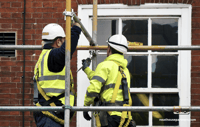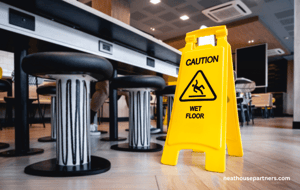Safety in Construction: A Snapshot for Employers
Safety in Construction: A Snapshot for Employers
James Rowland
Commercial Director James leads Account Management, Sales and Marketing at Neathouse Partners.Date
24 August 2023Updated
20 March 2024
Table of contents
Related articles
Tags
Construction is a sector full of potential health and safety hazards.
As an employer, your responsibility for ensuring safety isn't just about meeting regulatory requirements though, it's about valuing your staff and their wellbeing.
Read on for a brief overview of safety in construction, the legislation you need to be aware of, and the proactive measures you can take to meet your obligations as an employer.
Understanding the Importance of Safety
Construction safety involves protecting individuals from the physical, mental, and environmental risks they face in their roles.
As the construction industry has a high number of workplace injuries and fatalities, prioritising safety is both a moral and legal obligation for employers.
Prioritising safety in the workplace is crucial for several reasons.
- First and foremost, it helps protect the physical and mental well-being of employees
- Maintaining a strong safety record helps protect a company's reputation and prevent any negative impact on public perception.
- Compliance with regulations is also essential to avoid legal repercussions such as penalties and lawsuits.
- Promoting a safe work environment can boost productivity by reducing downtime and increasing overall efficiency.
Consequences of Negligence
The risks of neglecting health and safety in construction extend far beyond potential legal repercussions:
- Human Cost: Accidents and chronic health issues can lead to irreparable harm or fatalities.
- Financial Ramifications: Apart from legal fines, accidents can lead to project delays and increased costs.
- Reputation Damage: In the age of social media and instant news, a single accident can tarnish your company's reputation, impacting future business prospects.
Key Legislation Employers Must Be Aware Of
Construction (Design and Management) Regulations (CDM) 2015
The CDM 2015 is the primary set of regulations overseeing health, safety, and welfare in construction projects in the UK.
- Applies To: All construction projects, including domestic ones.
- Key Provisions:
- Defines roles and responsibilities.
- Requires a written construction phase plan.
- Mandates the appointment of a principal designer and principal contractor in projects with more than one contractor.
The Health and Safety at Work Act 1974
This is the primary legislation covering occupational health and safety in the UK.
- Applies To: All employers, employees, and self-employed individuals.
- Key Provisions:
- Employers must ensure the safety and health of employees and the public.
- Employees must take reasonable care of their own and others' safety.
The Work at Height Regulations 2005
Given the risks associated with working at heights in construction, these regulations provide a comprehensive framework.
- Applies To: All work at height where there's a risk of a fall that could cause injury.
- Key Provisions:
- Plan and organise work at height.
- Use the right type of equipment.
- Prioritise measures to protect everyone involved.
The Manual Handling Operations Regulations 1992
Given the physical demands of construction, these regulations are crucial.
- Applies To: Any work that involves lifting, lowering, pushing, pulling, or carrying.
- Key Provisions:
- Avoid hazardous manual handling.
- Assess the risk of injury.
- Reduce the risk as much as possible.
The Importance of Training and Education
Training isn't just about onboarding new employees; it's about continual learning.
As methodologies and technologies evolve, the training must keep pace.
This commitment ensures that every member of your team, regardless of their tenure or position, understands and respects the latest safety protocols.
For instance, the Health and Safety Executive (HSE) regularly updates its guidelines on various aspects of construction safety.
Staying aligned with these guidelines is more than just a matter of compliance; it's a commitment to excellence.
Benefits for your company:
- Reduced Accidents: Proper training can mitigate risks significantly.
- Employee Retention: Workers appreciate and tend to stay longer with employers who invest in their continuous development and safety.
- Reputation Boost: Being known as a company that prioritises training can position you as an industry leader.
Technological Advances
Technological advances have greatly contributed to improving safety in the construction industry.
Drones have become a popular tool for identifying potential hazards without risking the safety of staff.
By surveying sites, drones can provide a bird's-eye view of the area and detect any potential safety risks.
Moreover, advanced software can simulate building projects and anticipate challenges that may arise during construction.
This allows for the identification of safety concerns before they become a reality, which in turn saves time and resources, and most importantly, prevents accidents and injuries.
The use of technology in this way not only enhances safety but also promotes efficiency in the construction industry.
A Holistic View: Mental Health and Wellbeing
While physical safety is tangible and easily measurable, mental health often remains on the sidelines.
The stresses associated with construction - tight deadlines, high stakes, and physical demands - can be overwhelming.
Prioritising mental health is no longer a luxury; it's a necessity.
Initiatives could include regular check-ins, access to counselling, and mental health days.
Recognising and addressing mental health concerns is not only ethically right but can lead to improved productivity and morale.
Steps Employers Can Take to Protect Their Construction Workforce
Comprehensive Training
- Provide regular training to employees about potential hazards.
- Update training modules in line with new technologies and regulations.
Regular Site Audits
- Conduct routine inspections to identify and rectify safety hazards.
- Employ a dedicated safety officer or team, if feasible.
Personal Protective Equipment (PPE)
- Ensure the availability and usage of suitable PPE like helmets, safety boots, and high-visibility clothing.
- Conduct regular checks to ensure PPE's in good condition.
Encourage Reporting
- Foster an environment where employees can report hazards without fear.
- Act swiftly on reported concerns.
Mental Health Initiatives
- Recognise the stresses of construction work.
- Offer counselling and support for mental well-being.
Stay Updated
- Keep abreast of changes in safety regulations.
- Join industry associations and attend seminars to gain insights.
Summary
As an employer, you're in a unique position to shape the future of construction safety.
By adhering to regulations, committing to continuous training, leveraging technology, and fostering a holistic approach to health and wellbeing, you ensure not just the success of your projects, but the prosperity and health of your workforce.
It is crucial for companies in the construction industry to prioritise health and safety measures at every level of operations to avoid the severe consequences of negligence.
By implementing proper safety protocols and providing adequate training to employees, companies can ensure the well-being of their workers, avoid financial losses and project delays, and maintain a positive reputation in the industry.
By integrating safety, you not only comply with regulations but also build a resilient and thriving enterprise.
Next Steps
Neathouse Partners provides a comprehensive range of health and safety (H&S) services tailored for the construction sector.
Our team offers expert consultation on current H&S regulations and can assist you in conducting detailed risk assessments and delivering specialised training sessions for construction safety.
Additionally, we can support crafting up-to-date safety policies, managing incidents, performing periodic safety audits, and providing legal support to ensure compliance with evolving regulations.
With our continuous updates and custom solutions, we ensure that construction businesses operate safely, effectively, and in line with all legal requirements.
Related blog posts

Safe Techniques For Carrying Heavy Or Bulky loads At Work

6 Steps Staff Should Follow After An Accident At Work

Understanding Safety Signage Regulations as a UK Employer
Have questions?
Get in touch today
Contact us, and our team will get back to you within 24 hours. We value your questions and are committed to getting them answered quickly.


Hello! I am Nicky
Just fill in the form below with your details, and I will arrange for a member of our team to give you a call.
By clicking, you agree to our Privacy Policy






